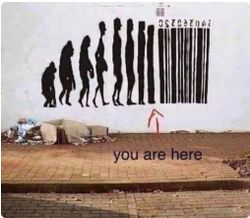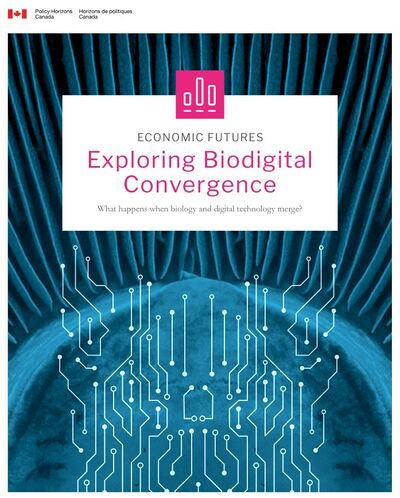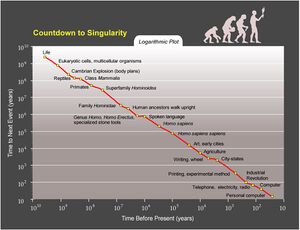Transhumanism
This is an import from Wikipedia and does not cover the deep state aspects/adherents good enough
 | |
| Interest of | • "Smart city" • Jacques Attali • Berggruen Institute • Nicolas Berggruen • Nick Bostrom • Jeffrey Epstein • Yuval Harari • Ray Kurzweil • Stéphanie Lacour • Elon Musk • Larry Page • SDS • The Great Reset • Peter Thiel • Carlo Maria Viganò • Luhan Yang |
| Superhuman concept with large billionaire following | |
Transhumanism is a philosophical movement that advocates for the transformation of the human species by developing and making widely available sophisticated technologies able to greatly modify or enhance human intellect and physiology.[1][2] The most common transhumanist thesis is that human beings may eventually be able to transform themselves into different beings with abilities so greatly expanded from the current condition as to merit the label of posthuman beings.[3].
The idea has a significant following among the global super-class of billionaires and their political proteges. With their vast resources and awareness of their own mortality and frail, aging bodies, the idea of living forever with augmented capabilities by hybridizing a genetically improved human body with artificially intelligent robots and the Internet, thereby creating a new breed of superior humans called ‘Transhumans’, has great appeal.
Trans-humanistic fantasies often describes, lightly disguised as an ethical dilemma, this new breed of supermen lording over common mortals, to the extent that they still will exist. The idea often ties in with eugenics and a large reduction in world population.
The big tech companies are pushing variants of the idea. Google has even hired their own in-house transhumanist, Ray Kurzweil.
“The 4th Industrial Revolution will lead to a fusion of our physical, our digital and our biological identities.”
Claus Schwab [4]
Contents
History
Precursors of transhumanism
According to Nick Bostrom, transcendentalist impulses have been expressed at least as far back as the quest for immortality in the Epic of Gilgamesh, as well as in historical quests for the Fountain of Youth, the Elixir of Life, and other efforts to stave off aging and death.[5]
There is debate about whether the philosophy of Friedrich Nietzsche can be considered an influence on transhumanism, despite its exaltation of the "Übermensch" (overman or superman), due to its emphasis on self-actualization rather than technological transformation.[6][7][8][9] The transhumanist philosophies of Max More and Stefan Lorenz Sorgner have been influenced strongly by Nietzschean thinking.[10] By way of contrast, The Transhumanist Declaration[11] "...advocates the well-being of all sentience (whether in artificial intellects, humans, posthumans, or non-human animals)".
Transhumanism and Eugenics

Fundamental ideas of transhumanism were first advanced in 1923 by the British geneticist J. B. S. Haldane in his essay Daedalus: Science and the Future, which predicted that great benefits would come from the application of advanced sciences to human biology—and that every such advance would first appear to someone as blasphemy or perversion, "indecent and unnatural". In particular, he was interested in the development of the science of eugenics, ectogenesis (creating and sustaining life in an artificial environment), and the application of genetics to improve human characteristics, such as health and intelligence.
The biologist Julian Huxley is generally regarded as the founder of transhumanism after using the term for the title of an influential 1957 article, where he defined it as "the human species can, if it wishes, transcend itself—not just sporadically, an individual here in one way, an individual there in another way, but in its entirety, as humanity."[12]
Huxley invented the term “transhumanism” just before he became President of the British Eugenics Society[13], 1959-62. Huxley was also the first Director General of UNESCO.
Huxley had similar preoccupations his entire career:
“unless [civilised societies] invent and enforce adequate measures for regulating human reproduction, for controlling the quantity of population, and at least preventing the deterioration of quality of racial stock, they are doomed to decay”
Julian Huxley (1926) [citation needed]
Artificial intelligence and the technological singularity
The concept of the technological singularity, or the ultra-rapid advent of superhuman intelligence, was first proposed by the British cryptologist I. J. Good in 1965:
Let an ultraintelligent machine be defined as a machine that can far surpass all the intellectual activities of any man however clever. Since the design of machines is one of these intellectual activities, an ultraintelligent machine could design even better machines; there would then unquestionably be an 'intelligence explosion,' and the intelligence of man would be left far behind. Thus the first ultraintelligent machine is the last invention that man need ever make.[14]
Computer scientist Marvin Minsky wrote on relationships between human and artificial intelligence beginning in the 1960s.[15] Over the succeeding decades, this field continued to generate influential thinkers such as Hans Moravec and Raymond Kurzweil, who oscillated between the technical arena and futuristic speculations in the transhumanist vein.[16][17] The coalescence of an identifiable transhumanist movement began in the last decades of the 20th century. In 1966, FM-2030 (formerly F. M. Esfandiary), a futurist who taught "new concepts of the human" at The New School, in New York City, began to identify people who adopt technologies, lifestyles and world views transitional to posthumanity as "transhuman".[18] In 1972, Robert Ettinger, whose 1964 Prospect of Immortality founded the cryonics movement,[19] contributed to the conceptualization of "transhumanity" with his 1972 Man into Superman.[20] FM-2030 published the Upwingers Manifesto in 1973.[21]
Theory
A common feature of transhumanism and philosophical posthumanism is the future vision of a new intelligent species, into which humanity will evolve and eventually will supplement or supersede it. Transhumanism stresses the evolutionary perspective, including sometimes the creation of a highly intelligent animal species by way of cognitive enhancement (i.e. biological uplift),[22] but clings to a "posthuman future" as the final goal of participant evolution.[23]
“Even if half the world’s species were lost [during genetic experiments], enormous diversity would still remain. When those in the distant future look back on this period of history, they will likely see it not as the era when the natural environment was impoverished, but as the age when a plethora of new forms—some biological, some technological, some a combination of the two—burst onto the scene. We best serve ourselves, as well as future generations, by focusing on the short-term consequences of our actions rather than our vague notions about the needs of the distant future.”
Gregory Stock (1993) [24]
Stock is former director of the program in Medicine, Technology, and Society at the UCLA School of Medicine
Aims
You awake one morning to find your brain has another lobe functioning. Invisible, this auxiliary lobe answers your questions with information beyond the realm of your own memory, suggests plausible courses of action, and asks questions that help bring out relevant facts. You quickly come to rely on the new lobe so much that you stop wondering how it works. You just use it. This is the dream of artificial intelligence.|Byte, April 1985[25]
While many transhumanist theorists and advocates seek to apply reason, science and technology for the purposes of reducing poverty, disease, disability and malnutrition around the globe,[26] transhumanism is distinctive in its particular focus on the applications of technologies to the improvement of human bodies at the individual level.
Transhumanist philosophers argue that there not only exists a perfectionist ethical imperative for humans to strive for progress and improvement of the human condition, but that it is possible and desirable for humanity to enter a transhuman phase of existence in which humans enhance themselves beyond what is naturally human. In such a phase, natural evolution would be replaced with deliberate participatory or directed evolution.
Some theorists such as Ray Kurzweil think that the pace of technological innovation is accelerating and that the next 50 years may yield not only radical technological advances, but possibly a technological singularity, which may fundamentally change the nature of human beings.[27] Transhumanists who foresee this massive technological change generally maintain that it is desirable. However, some are also concerned with the possible dangers of extremely rapid technological change and propose options for ensuring that advanced technology is used responsibly. For example, Bostrom has written extensively on existential risks to humanity's future welfare, including ones that could be created by emerging technologies.[28] In contrast, some proponents of transhumanism view it as essential to humanity's survival. For instance, Stephen Hawking points out that the "external transmission" phase of human evolution, where knowledge production and knowledge management is more important than transmission of information via evolution, may be the point at which human civilization becomes unstable and self-destructs, one of Hawking's explanations for the Fermi paradox. To counter this, Hawking emphasizes either self-design of the human genome or mechanical enhancement (e.g., brain-computer interface) to enhance human intelligence and reduce aggression, without which he implies human civilization may be too stupid collectively to survive an increasingly unstable system, resulting in societal collapse.[29]
Man and Superman
Unlike many philosophers, social critics and activists who place a moral value on preservation of natural systems, transhumanists see the very concept of the specifically natural as problematically nebulous at best and an obstacle to progress at worst.[30] In keeping with this, many prominent transhumanist advocates, such as Dan Agin, refer to transhumanism's critics, on the political right and left jointly, as "bioconservatives" or "bioluddites", the latter term alluding to the 19th century anti-industrialisation social movement that opposed the replacement of human manual labourers by machines.[31]
There are many who fear that the improvements afforded by a specific, privileged section of society will lead to a division of the human species into two different and distinct species.[32] The idea of two human species, one being at a great physical and economic advantage in comparison with the other, is a troublesome one at best. One may be incapable of breeding with the other, and may by consequence of lower physical health and ability, be considered of a lower moral standing than the other.
“The GenRich—who account for ten percent of the American population—[will] all carry synthetic genes. All aspects of the economy, the media, the entertainment industry, and the knowledge industry are controlled by members of the GenRich class…
“Naturals [unaltered humans] work as low-paid service providers or as laborers. [Eventually] the GenRich class and the Natural class will become entirely separate species with no ability to crossbreed, and with as much romantic interest in each other as a current human would have for a chimpanzee.
“Many think that it is inherently unfair for some people to have access to technologies that can provide advantages while others, less well-off, are forced to depend on chance alone, [but] American society adheres to the principle that personal liberty and personal fortune are the primary determinants of what individuals are allowed and able to do.
“Indeed, in a society that values individual freedom above all else, it is hard to find any legitimate basis for restricting the use of repro[grammed]-genetics. I will argue [that] the use of reprogenetic technologies is inevitable. [W]hether we like it or not, the global marketplace will reign supreme.”
Lee Silver (1998) [33]
Lee Silver is a molecular biologist at Princeton University
Technologies of interest
| James Corbett made a documentary abut it (also at https://www.bitchute.com/video/INC5y4lZTlE) |
Transhumanists support the emergence and convergence of technologies including nanotechnology, biotechnology, information technology and cognitive science (NBIC), as well as hypothetical future technologies like simulated reality, artificial intelligence, superintelligence, 3D bioprinting, mind uploading, chemical brain preservation and cryonics. They believe that humans can and should use these technologies to become more than human.[34] Therefore, they support the recognition and/or protection of cognitive liberty, morphological freedom and procreative liberty as civil liberties, so as to guarantee individuals the choice of using human enhancement technologies on themselves and their children.[35] Some speculate that human enhancement techniques and other emerging technologies may facilitate more radical human enhancement no later than at the midpoint of the 21st century. Kurzweil's book The Singularity is Near and Michio Kaku's book Physics of the Future outline various human enhancement technologies and give insight on how these technologies may impact the human race.[36][37]
Neuroscientist Anders Sandberg has been practicing on the method of scanning ultra-thin sections of the brain. This method is being used to help better understand the architecture of the brain. As of now, this method is currently being used on mice. This is the first step towards hypothetically uploading contents of the human brain, including memories and emotions, onto a computer.[38]
Military Research
Especially the US military has shown extensive interest in transhumanistic technologies:
DARPA, the US Department of Defense's research arm, is paying scientists to invent ways to instantly read soldiers' minds using tools like genetic engineering of the human brain, nanotechnology and infrared beams.[39]
In 2019, six teams received funding under the Next-Generation Nonsurgical Neurotechnology (N3) program, tasked with developing technology that will provide a two-way channel for rapid and seamless communication between the human brain and machines without requiring surgery.
Jacob Robinson, an assistant professor of bioengineering at Rice University, who is leading one of the teams, plans to use viruses modified to deliver genetic material into cells — called viral vectors — to insert DNA into specific neurons that will make them produce two kinds of proteins.
The first type of protein absorbs light when a neuron is firing, which makes it possible to detect neural activity. Because of the protein, the targeted areas will appear darker (absorbing light) when neurons are firing, generating a read of brain activity that can be used by a headset to work out what the person is seeing, hearing or trying to do.
The second protein tethers to magnetic nanoparticles, so the neurons can be magnetically stimulated to fire when the headset generates a magnetic field. This could be used to stimulate neurons so as to induce an image or sound in the patient's mind.
In 2011, DARPA revealed plans to create an elite fighting force by creating software which could be uploaded directly to the brain to give their soldiers heightened senses[40]
DARPA is also working on triggering genes that will make soldiers' bodies able to convert fat into energy more efficiently so they are able to go days without eating while in the warzone. "Soldiers would be able to run at Olympic speeds, carry large weights and go without sleep and without food."<ref.https://www.dailymail.co.uk/sciencetech/article-2187276/U-S-Army-Soldiers-able-run-Olympic-speed-wont-need-food-sleep-gene-technology.html</ref>
Currents

There is a variety of opinions within transhumanist thought. Many of the leading transhumanist thinkers hold views that are under constant revision and development.[43] Some distinctive currents of transhumanism are identified and listed here in alphabetical order:
- Democratic transhumanism, a political ideology synthesizing liberal democracy, social democracy, radical democracy and transhumanism.[44]
- Extropianism, an early school of transhumanist thought characterized by a set of principles advocating a proactive approach to human evolution.[45]
- Immortalism, a moral ideology based upon the belief that radical life extension and technological immortality is possible and desirable, and advocating research and development to ensure its realization.[46]
- Libertarian transhumanism, a political ideology synthesizing libertarianism and transhumanism.[47]
- Postgenderism, a social philosophy which seeks the voluntary elimination of gender in the human species through the application of advanced biotechnology and assisted reproductive technologies.[48]
- Postpoliticism, a transhumanist political proposal that aims to create a "postdemocratic state" based on reason and free access of enhancement technologies to people.[49]
- Singularitarianism, a moral ideology based upon the belief that a technological singularity is possible, and advocating deliberate action to effect it and ensure its safety.[50]
- Technogaianism, an ecological ideology based upon the belief that emerging technologies can help restore Earth's environment and that developing safe, clean, alternative technology should therefore be an important goal of environmentalists.[51]
- Equalism, a socioeconomic theory based upon the idea that emerging technologies will put an end to social stratification through even distribution of resources in the technological singularity era.[52]
Practice
While some transhumanists take an abstract and theoretical approach to the perceived benefits of emerging technologies, others have offered specific proposals for modifications to the human body, including heritable ones. Transhumanists are often concerned with methods of enhancing the human nervous system. Though some, such as Kevin Warwick, propose modification of the peripheral nervous system, the brain is considered the common denominator of personhood and is thus a primary focus of transhumanist ambitions.[53]
In fact, Warwick has gone a lot further than merely making a proposal. In 2002 he had a 100 electrode array surgically implanted into the median nerves of his left arm in order to link his nervous system directly with a computer and thus to also connect with the internet. As a consequence, he carried out a series of experiments. He was able to directly control a robot hand using his neural signals and to feel the force applied by the hand through feedback from the fingertips. He also experienced a form of ultrasonic sensory input and conducted the first purely electronic communication between his own nervous system and that of his wife who also had electrodes implanted.[54]

As proponents of self-improvement and body modification, transhumanists tend to use existing technologies and techniques that supposedly improve cognitive and physical performance, while engaging in routines and lifestyles designed to improve health and longevity.[55] Depending on their age, some transhumanists express concern that they will not live to reap the benefits of future technologies. However, many have a great interest in life extension strategies and in funding research in cryonics in order to make the latter a viable option of last resort, rather than remaining an unproven method.[56]
“I'm looking into parabiosis stuff, which I think is really interesting. This is where they did the young blood into older mice and they found that had a massive rejuvenating effect,” he said. “And so that’s . . . that is one that . . . again, it’s one of these very odd things where people had done these studies in the 1950s and then it got dropped altogether. I think there are a lot of these things that have been strangely under-explored.”
Peter Thiel [57]
Allegedly, Thiel “spends $40,000 per quarter to get an infusion of blood from an 18-year-old"
While most transhumanist theory focuses on future technologies and the changes they may bring, many today are already involved in the practice on a very basic level. It is not uncommon for many to receive cosmetic changes to their physical form via cosmetic surgery, even if it is not required for health reasons. Human growth hormones attempt to alter the natural development of shorter children or those who have been born with a physical deficiency. Doctors prescribe medicines such as Ritalin and Adderall to improve cognitive focus, and many people take "lifestyle" drugs such as Viagra, Propecia, and Botox to restore aspects of youthfulness that have been lost in maturity.[58]
Other transhumanists, such as cyborg artist Neil Harbisson, use technologies and techniques to improve their senses and perception of reality. Harbisson's antenna, which is permanently implanted in his skull, allows him to sense colours beyond human perception such as infrareds and ultraviolets.[59]
Feasibility
In a 1992 book, sociologist Max Dublin pointed to many past failed predictions of technological progress and argued that modern futurist predictions would prove similarly inaccurate. He also objected to what he saw as scientism, fanaticism and nihilism by a few in advancing transhumanist causes. Dublin also said that historical parallels existed between Millenarian religions and Communist doctrines.[60]
Although generally sympathetic to transhumanism, public health professor Gregory Stock is skeptical of the technical feasibility and mass appeal of the cyborgization of humanity predicted by Raymond Kurzweil, Hans Moravec and Kevin Warwick. He said that, throughout the 21st century, many humans would find themselves deeply integrated into systems of machines, but would remain biological. Primary changes to their own form and character would arise not from cyberware, but from the direct manipulation of their genetics, metabolism and biochemistry.[61]
Another critique is aimed mainly at "algeny" (a portmanteau of alchemy and genetics), which Jeremy Rifkin defined as "the upgrading of existing organisms and the design of wholly new ones with the intent of 'perfecting' their performance".[62] It emphasizes the issue of biocomplexity and the unpredictability of attempts to guide the development of products of biological evolution. This argument, elaborated in particular by the biologist Stuart Newman, is based on the recognition that cloning and germline genetic engineering of animals are error-prone and inherently disruptive of embryonic development. Accordingly, so it is argued, it would create unacceptable risks to use such methods on human embryos. Performing experiments, particularly ones with permanent biological consequences, on developing humans would thus be in violation of accepted principles governing research on human subjects (see the 1964 Declaration of Helsinki). Moreover, because improvements in experimental outcomes in one species are not automatically transferable to a new species without further experimentation, it is claimed that there is no ethical route to genetic manipulation of humans at early developmental stages.[63]
As a practical matter, however, international protocols on human subject research may not present a legal obstacle to attempts by transhumanists and others to improve their offspring by germinal choice technology. According to legal scholar Kirsten Rabe Smolensky, existing laws would protect parents who choose to enhance their child's genome from future liability arising from adverse outcomes of the procedure.[64]
Loss of human identity

In his 2003 book Enough: Staying Human in an Engineered Age, environmental ethicist Bill McKibben argued at length against many of the technologies that are postulated or supported by transhumanists, including germinal choice technology, nanomedicine and life extension strategies. He claims that it would be morally wrong for humans to tamper with fundamental aspects of themselves (or their children) in an attempt to overcome universal human limitations, such as vulnerability to aging, maximum life span and biological constraints on physical and cognitive ability. Attempts to "improve" themselves through such manipulation would remove limitations that provide a necessary context for the experience of meaningful human choice. He claims that human lives would no longer seem meaningful in a world where such limitations could be overcome technologically. Even the goal of using germinal choice technology for clearly therapeutic purposes should be relinquished, since it would inevitably produce temptations to tamper with such things as cognitive capacities. He argues that it is possible for societies to benefit from renouncing particular technologies, using as examples Ming China, Tokugawa Japan and the contemporary Amish.[66]
Biopolitical activist Jeremy Rifkin and biologist Stuart Newman accept that biotechnology has the power to make profound changes in organismal identity. They argue against the genetic engineering of human beings because they fear the blurring of the boundary between human and artifact.[67][68] Philosopher Keekok Lee sees such developments as part of an accelerating trend in modernization in which technology has been used to transform the "natural" into the "artefactual".[69] In the extreme, this could lead to the manufacturing and enslavement of "monsters" such as human clones, human-animal chimeras, or bioroids, but even lesser dislocations of humans and non-humans from social and ecological systems are seen as problematic. The film Blade Runner (1982) and the novels The Boys From Brazil (1976) and The Island of Doctor Moreau (1896) depict elements of such scenarios, but Mary Shelley's 1818 novel Frankenstein is most often alluded to by critics who suggest that biotechnologies could create objectified and socially unmoored people as well as subhumans. Such critics propose that strict measures be implemented to prevent what they portray as dehumanizing possibilities from ever happening, usually in the form of an international ban on human genetic engineering.[70]
Writing in Reason magazine, Science journalist Ronald Bailey has accused opponents of research involving the modification of animals as indulging in alarmism when they speculate about the creation of subhuman creatures with human-like intelligence and brains resembling those of Homo sapiens. Bailey insists that the aim of conducting research on animals is simply to produce human health care benefits.[71]
A different response comes from transhumanist personhood theorists who object to what they characterize as the anthropomorphobia fueling some criticisms of this research, which science fiction writer Isaac Asimov termed the "Frankenstein complex". For example, Woody Evans argues that, provided they are self-aware, human clones, human-animal chimeras and uplifted animals would all be unique persons deserving of respect, dignity, rights, responsibilities, and citizenship.[72] They conclude that the coming ethical issue is not the creation of so-called monsters, but what they characterize as the "yuck factor" and "human-racism", that would judge and treat these creations as monstrous.[73][74]
At least one public interest organization, the U.S.-based Center for Genetics and Society, was formed, in 2001, with the specific goal of opposing transhumanist agendas that involve transgenerational modification of human biology, such as full-term human cloning and germinal choice technology. The Institute on Biotechnology and the Human Future of the Chicago-Kent College of Law critically scrutinizes proposed applications of genetic and nanotechnologies to human biology in an academic setting.
Genetic divide
Some critics of libertarian transhumanism have focused on the likely socioeconomic consequences in societies in which divisions between rich and poor are on the rise. Bill McKibben, for example, suggests that emerging human enhancement technologies would be disproportionately available to those with greater financial resources, thereby exacerbating the gap between rich and poor and creating a "genetic divide".[75] Even Lee M. Silver, the biologist and science writer who coined the term "reprogenetics" and supports its applications, has expressed concern that these methods could create a two-tiered society of genetically engineered "haves" and "have nots" if social democratic reforms lag behind implementation of enhancement technologies.[76] The 1997 film Gattaca depicts a dystopian society in which one's social class depends entirely on genetic potential and is often cited by critics in support of these views.[77]
These criticisms are also voiced by non-libertarian transhumanist advocates, especially self-described democratic transhumanists, who believe that the majority of current or future social and environmental issues (such as unemployment and resource depletion) need to be addressed by a combination of political and technological solutions (like a guaranteed minimum income and alternative technology). Therefore, on the specific issue of an emerging genetic divide due to unequal access to human enhancement technologies, bioethicist James Hughes, in his 2004 book Citizen Cyborg: Why Democratic Societies Must Respond to the Redesigned Human of the Future, argues that progressives or, more precisely, techno-progressives must articulate and implement public policies (i.e., a universal health care voucher system that covers human enhancement technologies) in order to attenuate this problem as much as possible, rather than trying to ban human enhancement technologies. The latter, he argues, might actually worsen the problem by making these technologies unsafe or available only to the wealthy on the local black market or in countries where such a ban is not enforced.[78]
Sometimes, as in the writings of Leon Kass, the fear is that various institutions and practices judged as fundamental to civilized society would be damaged or destroyed.[79] In his 2002 book Our Posthuman Future and in a 2004 Foreign Policy magazine article, political economist and philosopher Francis Fukuyama designates transhumanism as the world's most dangerous idea because he believes that it may undermine the egalitarian ideals of democracy (in general) and liberal democracy (in particular) through a fundamental alteration of "human nature".[80] Social philosopher Jürgen Habermas makes a similar argument in his 2003 book The Future of Human Nature, in which he asserts that moral autonomy depends on not being subject to another's unilaterally imposed specifications. Habermas thus suggests that the human "species ethic" would be undermined by embryo-stage genetic alteration.[81] Critics such as Kass, Fukuyama and a variety of authors hold that attempts to significantly alter human biology are not only inherently immoral, but also threaten the social order. Alternatively, they argue that implementation of such technologies would likely lead to the "naturalizing" of social hierarchies or place new means of control in the hands of totalitarian regimes. AI pioneer Joseph Weizenbaum criticizes what he sees as misanthropic tendencies in the language and ideas of some of his colleagues, in particular Marvin Minsky and Hans Moravec, which, by devaluing the human organism per se, promotes a discourse that enables divisive and undemocratic social policies.[82]
Specter of coercive eugenicism
Some critics of transhumanism see the old eugenics, social Darwinist, and master race ideologies and programs of the past as warnings of what the promotion of eugenic enhancement technologies might unintentionally encourage. Some fear future "eugenics wars" as the worst-case scenario: the return of coercive state-sponsored genetic discrimination and human rights violations such as compulsory sterilization of persons with genetic defects, the killing of the institutionalized and, specifically, segregation and genocide of races perceived as inferior.[83] Health law professor George Annas and technology law professor Lori Andrews are prominent advocates of the position that the use of these technologies could lead to such human-posthuman caste warfare.[84][85]
The major transhumanist organizations strongly condemn the coercion involved in such policies and reject the racist and classist assumptions on which they were based, along with the pseudoscientific notions that eugenic improvements could be accomplished in a practically meaningful time frame through selective human breeding.[86] Instead, most transhumanist thinkers advocate a "new eugenics", a form of egalitarian liberal eugenics.[87] In their 2000 book From Chance to Choice: Genetics and Justice, non-transhumanist bioethicists Allen Buchanan, Dan Brock, Norman Daniels and Daniel Wikler have argued that liberal societies have an obligation to encourage as wide an adoption of eugenic enhancement technologies as possible (so long as such policies do not infringe on individuals' reproductive rights or exert undue pressures on prospective parents to use these technologies) in order to maximize public health and minimize the inequalities that may result from both natural genetic endowments and unequal access to genetic enhancements.[88] Most transhumanists holding similar views nonetheless distance themselves from the term "eugenics" (preferring "germinal choice" or "reprogenetics")[89] to avoid having their position confused with the discredited theories and practices of early-20th-century eugenic movements.
Existential risks
In his 2003 book Our Final Hour, British Astronomer Royal Martin Rees argues that advanced science and technology bring as much risk of disaster as opportunity for progress. However, Rees does not advocate a halt to scientific activity. Instead, he calls for tighter security and perhaps an end to traditional scientific openness.[90] Advocates of the precautionary principle, such as many in the environmental movement, also favor slow, careful progress or a halt in potentially dangerous areas. Some precautionists believe that artificial intelligence and robotics present possibilities of alternative forms of cognition that may threaten human life.[91]
Transhumanists do not necessarily rule out specific restrictions on emerging technologies so as to lessen the prospect of existential risk. Generally, however, they counter that proposals based on the precautionary principle are often unrealistic and sometimes even counter-productive as opposed to the technogaian current of transhumanism, which they claim is both realistic and productive. In his television series Connections, science historian James Burke dissects several views on technological change, including precautionism and the restriction of open inquiry. Burke questions the practicality of some of these views, but concludes that maintaining the status quo of inquiry and development poses hazards of its own, such as a disorienting rate of change and the depletion of our planet's resources. The common transhumanist position is a pragmatic one where society takes deliberate action to ensure the early arrival of the benefits of safe, clean, alternative technology, rather than fostering what it considers to be anti-scientific views and technophobia.
Nick Bostrom argues that even barring the occurrence of a singular global catastrophic event, basic Malthusian and evolutionary forces facilitated by technological progress threaten to eliminate the positive aspects of human society.[92]
One transhumanist solution proposed by Bostrom to counter existential risks is control of differential technological development, a series of attempts to influence the sequence in which technologies are developed. In this approach, planners would strive to retard the development of possibly harmful technologies and their applications, while accelerating the development of likely beneficial technologies, especially those that offer protection against the harmful effects of others.[93]
An example
| Page name | Description |
|---|---|
| Optogenetics | A biological technique that involves the use of light to control neurons;A Virtual Reality System for Controlling Living Cells |
Related Quotations
| Page | Quote | Author | Date |
|---|---|---|---|
| Ray Kurzweil | “Our thinking then will be a hybrid of biological and non-biological thinking. We’ll be able to extend our limitations and think in the cloud. We’re going to put gateways to the cloud in our brains...We’re going to gradually merge and enhance ourselves. In my view, that’s the nature of being human – we transcend our limitations.” | Ray Kurzweil | 2015 |
| Elon Musk | “Under any rate of advancement in AI we will be left behind by a lot. The benign situation with ultra-intelligent AI is that we would be so far below in intelligence we’d be like a pet, or a house cat. I don’t love the idea of being a house cat. The solution that seems maybe the best one is to have an AI layer. A third digital layer that could work symbiotically [with your brain].” | Elon Musk | 2016 |
| Peter Thiel | “I'm looking into parabiosis stuff, which I think is really interesting. This is where they did the young blood into older mice and they found that had a massive rejuvenating effect,” he said. “And so that’s... that is one that... again, it’s one of these very odd things where people had done these studies in the 1950s and then it got dropped altogether. I think there are a lot of these things that have been strangely under-explored.” | Peter Thiel |
References
- ↑ Mercer, Calvin. Religion and Transhumanism: The Unknown Future of Human Enhancement. Praeger.
- ↑ Bostrom, Nick (2005) http://www.nickbostrom.com/papers/history.pdf
- ↑ Bostrom, Nick (2005) http://www.nickbostrom.com/papers/history.pdf
- ↑ https://www.bitchute.com/video/I3tNprwfNfwP/
- ↑ Bostrom, Nick (2005) http://www.nickbostrom.com/papers/history.pdf
- ↑ Bostrom, Nick (2005) http://www.nickbostrom.com/papers/history.pdf
- ↑ http://jetpress.org/v20/sorgner.htm
- ↑ name="Blackford 2010"
- ↑ name="Sorgner 2012"
- ↑ http://jetpress.org/v20/sorgner.htm
- ↑ https://web.archive.org/web/20060910010545/http://www.transhumanism.org/index.php/WTA/faq21/79/
- ↑ https://web.archive.org/web/20160625132722/http://www.transhumanism.org/index.php/WTA/more/huxley
- ↑ https://www.hli.org/resources/history-of-eugenics-movement/
- ↑ https://web.archive.org/web/20090420061605/http://www.aeiveos.com/~bradbury/Authors/Computing/Good-IJ/SCtFUM.html "Speculations Concerning the First Ultraintelligent Machine"
- ↑ http://web.media.mit.edu/~minsky/papers/steps.html
- ↑ name="Moravec 1998"
- ↑ name="Kurzweil 1999"
- ↑ https://archive.org/details/areyoutranshuman00fm20
- ↑ https://www.theguardian.com/science/2016/nov/18/the-cryonics-dilemma-will-deep-frozen-bodies-be-fit-for-new-life
- ↑ name="Ettinger 1972"
- ↑ name="FM-2030 1973"
- ↑ https://en.wikipedia.org/wiki/Citizen_Cyborg
- ↑ name="Bostrom 2006">cite web | last = Bostrom | first = Nick | title = Why I Want to be a Posthuman When I Grow Up | url = http://www.nickbostrom.com/posthuman.pdf | access-date = December 10, 2007
- ↑ http://lobby.la.psu.edu/_107th/121_Human_Cloning/Organizational_Statements/CGS/CGS_Quiet_Campaign_01.htm Orignally from his book "Metaman: The Merging of Humans and Machines into a Global Superorganism."
- ↑ https://web.archive.org/web/20150420115129/https://archive.org/stream/byte-magazine-1985-04/1985_04_BYTE_10-04_Artificial_Intelligence#page/n125/mode/2up
- ↑ name="What is Transhumanism"
- ↑ name="Kurzweil 2005"
- ↑ name="Bostrom 2002"
- ↑ https://web.archive.org/web/20060421051343/http://www.hawking.org.uk/lectures/life.html
- ↑ http://www.nickbostrom.com/evolution.pdf
- ↑ http://www.changesurfer.com/Acad/TranshumPolitics.htm
- ↑ name=":0">Cite journal|jstor=27719694|doi=10.1136/jme.2005.013789|pmid=16943331|pmc=2563415
- ↑ https://reader.exacteditions.com/issues/49426/page/10
- ↑ name="Naam 2005"
- ↑ name="Sandberg 2001"
- ↑ name="Kurzweil 2005"
- ↑ cite book|last=Kaku|first=Michio|title=Physics of the Future|year=2011|publisher=Doubleday|location=United States|page=389
- ↑ http://www.fhi.ox.ac.uk/Reports/2008-3.pdf
- ↑ https://www.livescience.com/65546-darpa-mind-controlled-weapons.html
- ↑ https://www.express.co.uk/news/world/1005512/US-military-DARPA-super-soldiers-mysterious-experiments
- ↑ http://web.archive.org/web/20200308031820/https://horizons.gc.ca/wp-content/uploads/2020/02/Biodigital-Convergence-with-Links-Final-02062020.pdf
- ↑ http://archive.today/2021.05.24-025355/https://horizons.gc.ca/en/2020/02/11/exploring-biodigital-convergence/
- ↑ https://web.archive.org/web/20071016194900/http://www.transhumanism.org/index.php/WTA/faq21/81/
- ↑ http://www.changesurfer.com/Acad/DemocraticTranshumanism.htm
- ↑ https://web.archive.org/web/20051029125153/http://www.maxmore.com/transhum.htm
- ↑ http://www.imminst.org/
- ↑ http://www.changesurfer.com/Acad/TranshumPolitics.htm
- ↑ http://sentientdevelopments.blogspot.com/2008/03/postgenderism-beyond-gender-binary.html
- ↑ https://www.researchgate.net/publication/327756347
- ↑ https://en.wikipedia.org/wiki/The_Singularity_Is_Near
- ↑ http://www.changesurfer.com/Acad/DemocraticTranshumanism.htm
- ↑ Newton Lee (2019). The Transhumanism Handbook. Springer Nature.
- ↑ name="Walker 2002"
- ↑ name="doi10.1001/archneur.60.10.1369|noedit">Cite journal | doi = 10.1001/archneur.60.10.1369| pmid = 14568806| title = The Application of Implant Technology for Cybernetic Systems| journal = Archives of Neurology| volume = 60| issue = 10| pages = 1369–73| year = 2003
- ↑ name="Kurzweil 1993"
- ↑ name="Kurzweil 2004"
- ↑ https://www.vanityfair.com/news/2016/08/peter-thiel-wants-to-inject-himself-with-young-peoples-blood
- ↑ Cite journal|jstor=40260800|title=Humanity 2.0|journal=The Wilson Quarterly |volume=27|issue=4|pages=13–20|last1=Elliott|first1=Carl|year=2003
- ↑ Adams, Tim "When man meets metal: rise of the transhumans", The Guardian, 29 October 2017
- ↑ name="Dublin 1992"
- ↑ name="Stock 2002"
- ↑ name="Rifkin 1983"
- ↑ name="Newman 2003"
- ↑ name="Smolensky 2006"
- ↑ name="Alexander 2000"
- ↑ name="McKibben 2003"
- ↑ name="Newman 2003"
- ↑ name="Otchet 1998"
- ↑ name="Lee 1999"
- ↑ name="Darnovsky Crossroads"
- ↑ name="Bailey 2001"
- ↑ Name="Evans 2015"
- ↑ https://en.wikipedia.org/wiki/Citizen_Cyborg
- ↑ name="Glenn 2003"
- ↑ name="McKibben 2003"
- ↑ name="Silver 1998"
- ↑ https://en.wikipedia.org/wiki/Citizen_Cyborg
- ↑ https://en.wikipedia.org/wiki/Citizen_Cyborg
- ↑ name="Kass 2001"
- ↑ name="Fukuyama 2004"
- ↑ name="Habermas 2004"
- ↑ name="Platt 1995"
- ↑ name="Black 2003"
- ↑ name="Darnovsky Crossroads"
- ↑ name="Annas 2002"
- ↑ name="Bashford545">cite book | title= The Oxford Handbook of The History of Eugenics | author= Bashford, A. and Levine, P. | page= 545| publisher = Oxford University Press | year= 2010 | isbn= 9780195373141
- ↑ name="WTA FAQ 3.2"
- ↑ name="Buchanan 2000"
- ↑ name="Silver 1998"
- ↑ name="Rees 2003"
- ↑ name="Arnall 2003"
- ↑ name="bostrom-evolution">cite journal|last1=Bostrom|first1=Nick|title=The Future of Human Evolution|journal=Bedeutung|volume=284|issue=3|page=8|date=2009|url=http://www.nickbostrom.com/fut/evolution.html%7Cbibcode=2001SciAm.284c...8R%7Cdoi=10.1038/scientificamerican0301-8
- ↑ name="Bostrom 2002"
Wikipedia is not affiliated with Wikispooks. Original page source here

